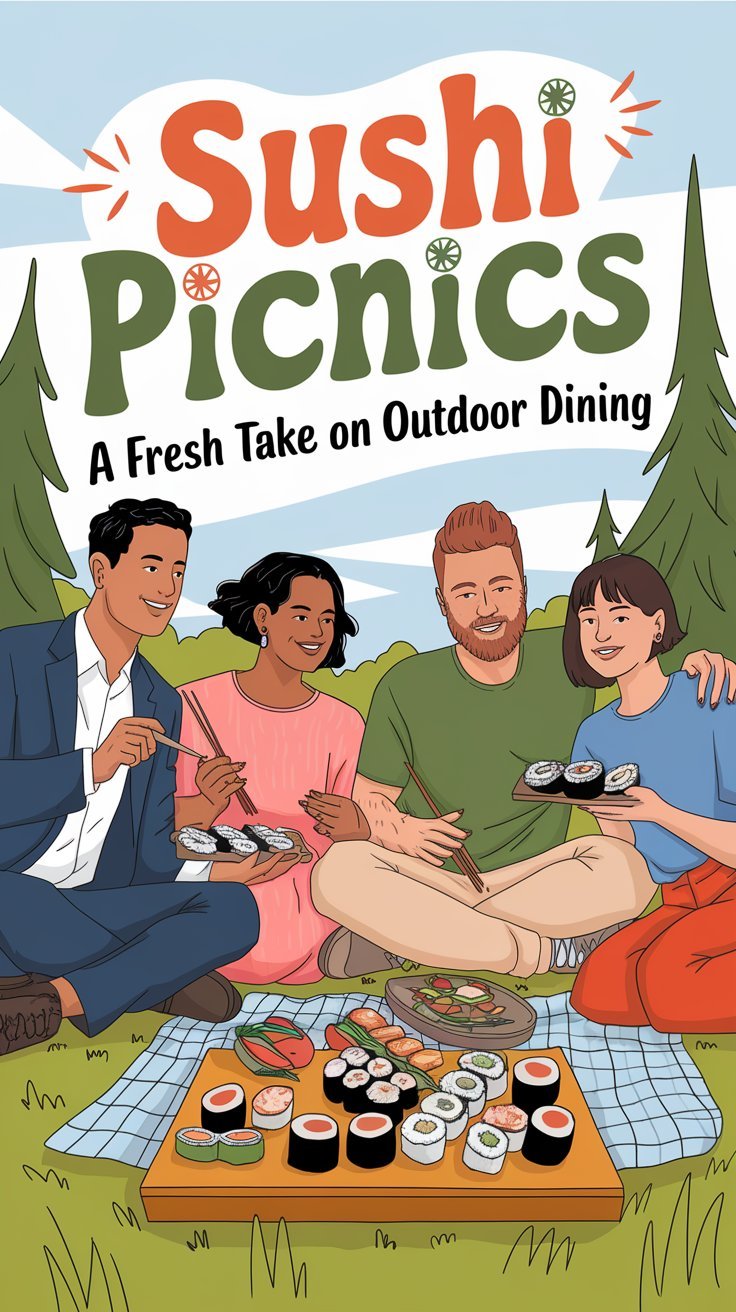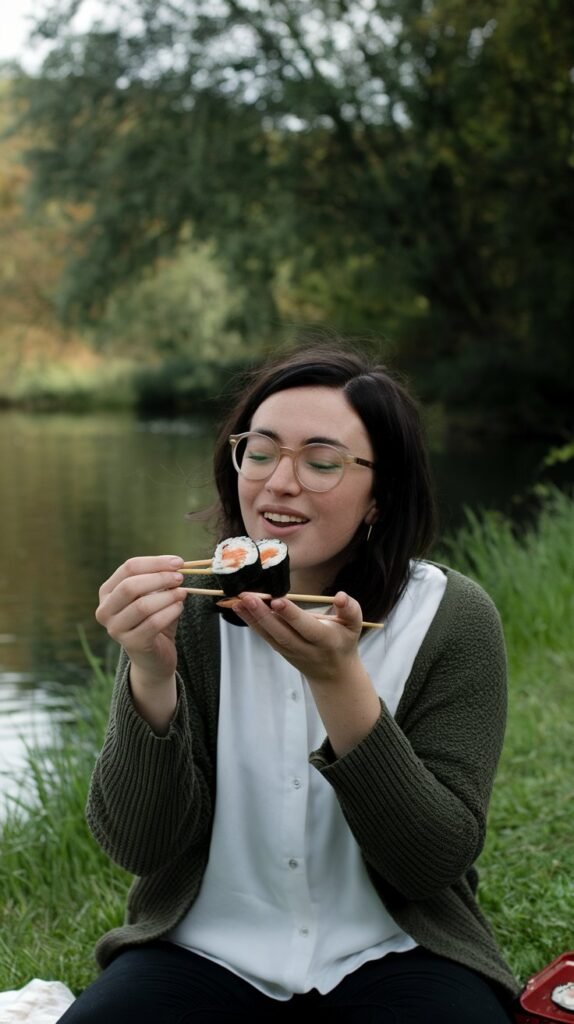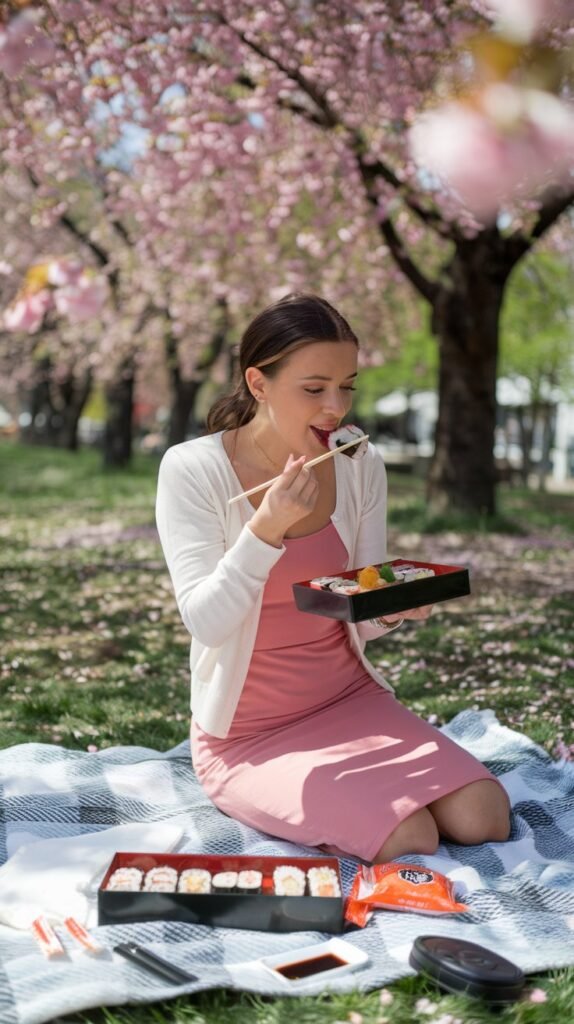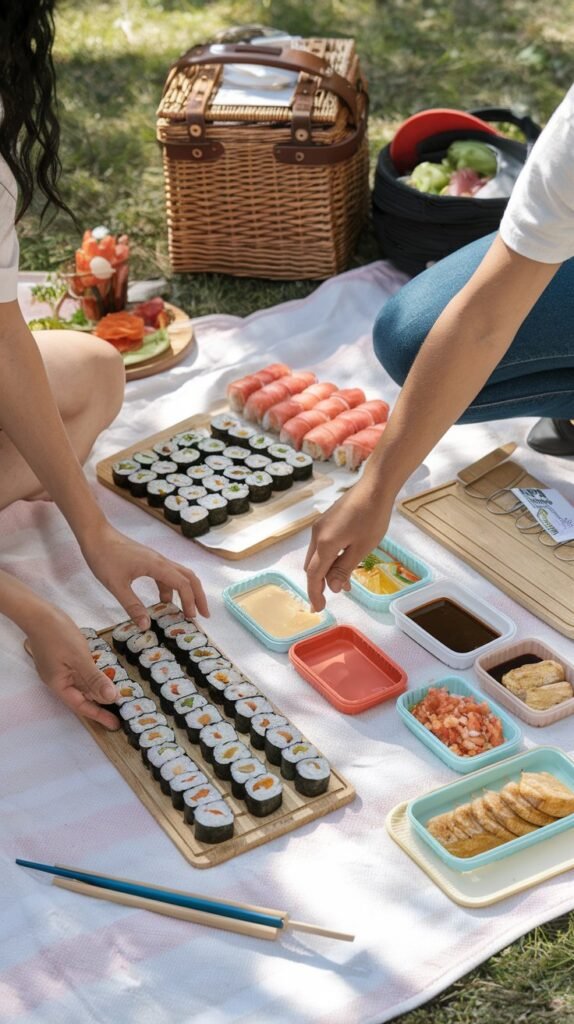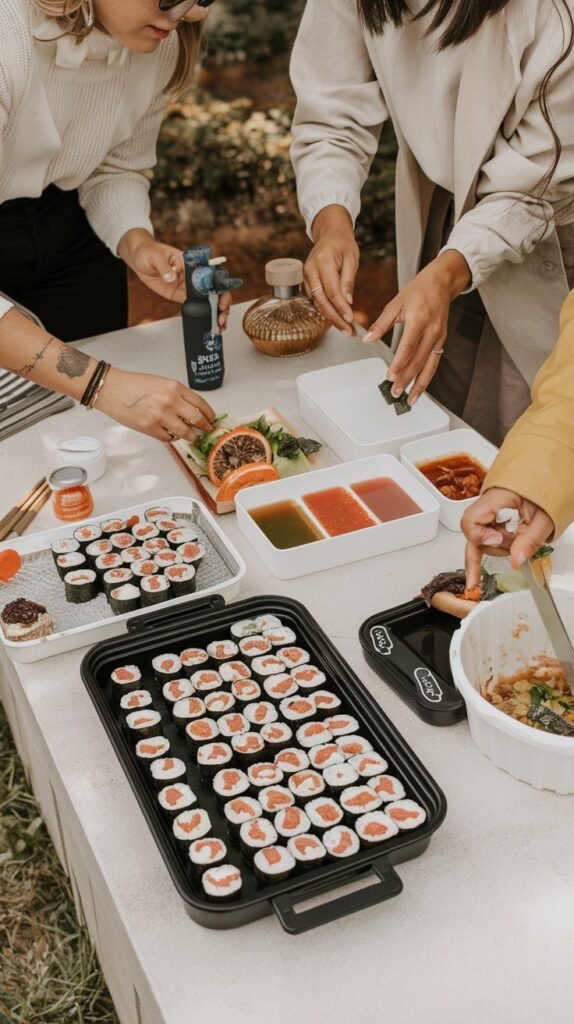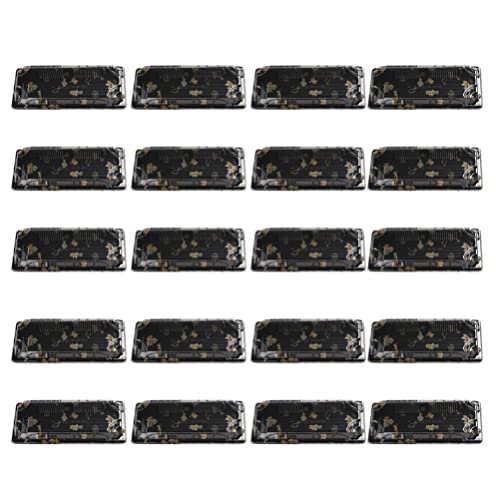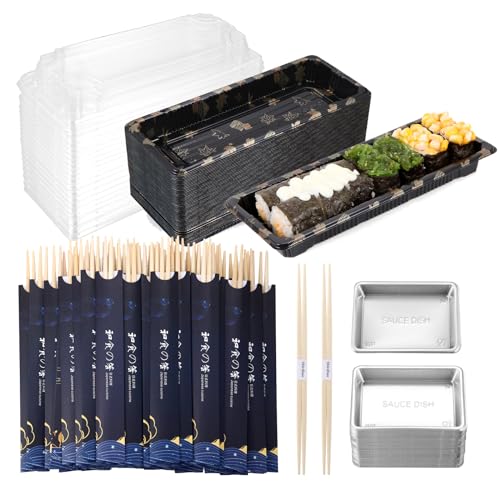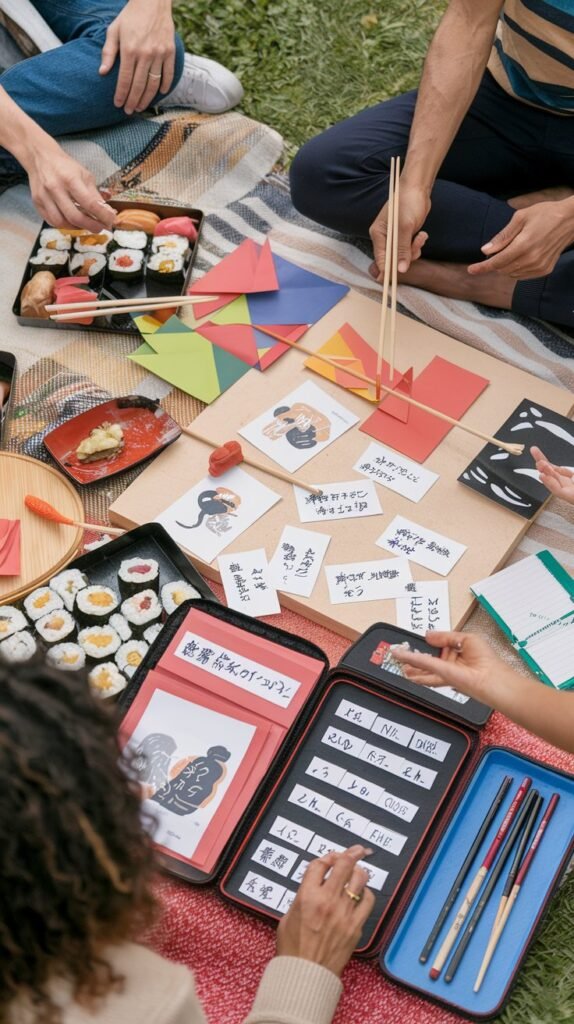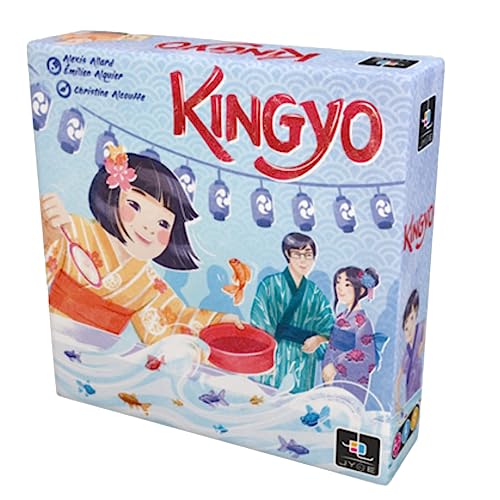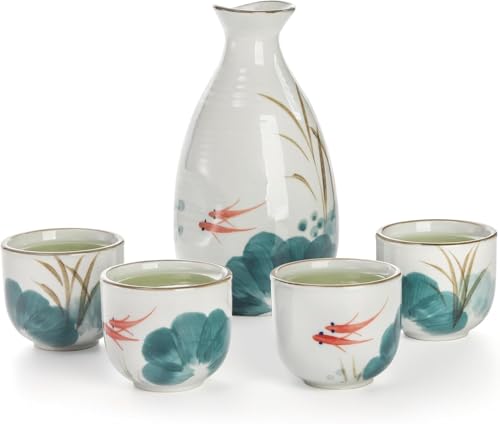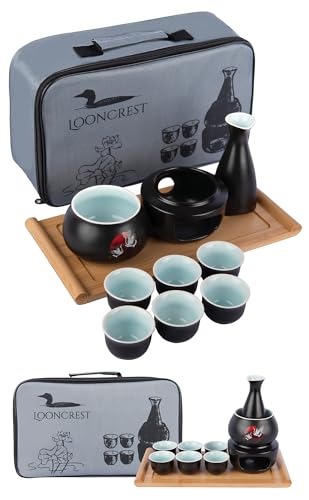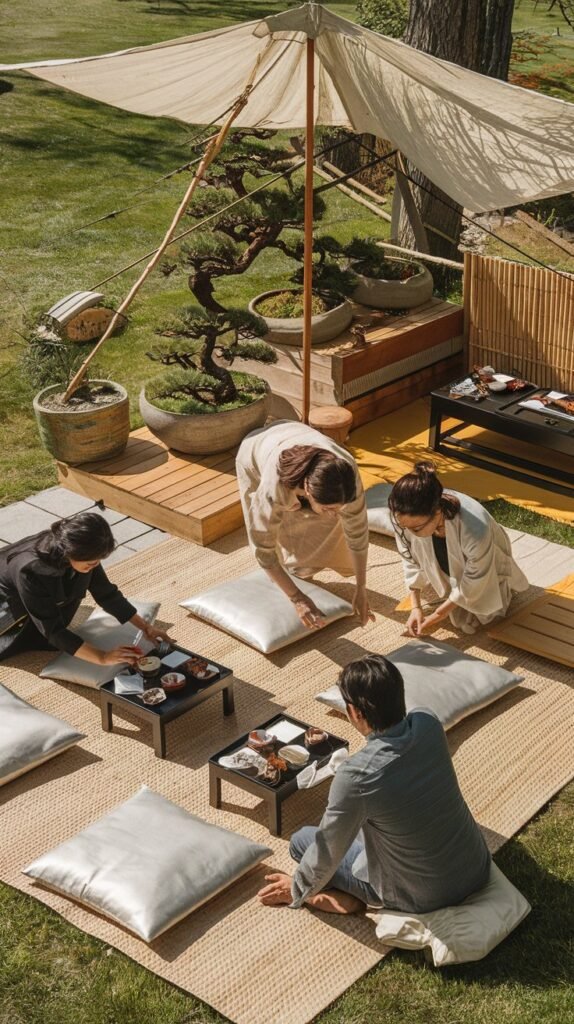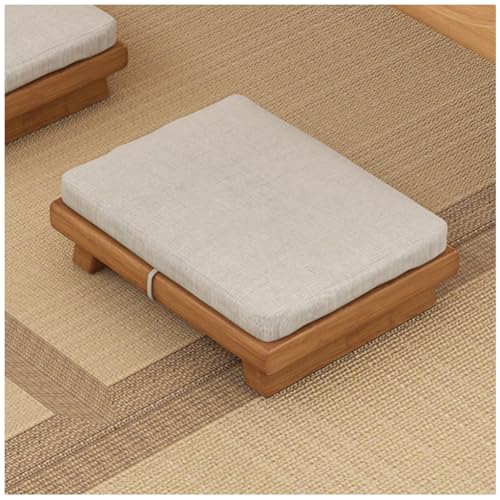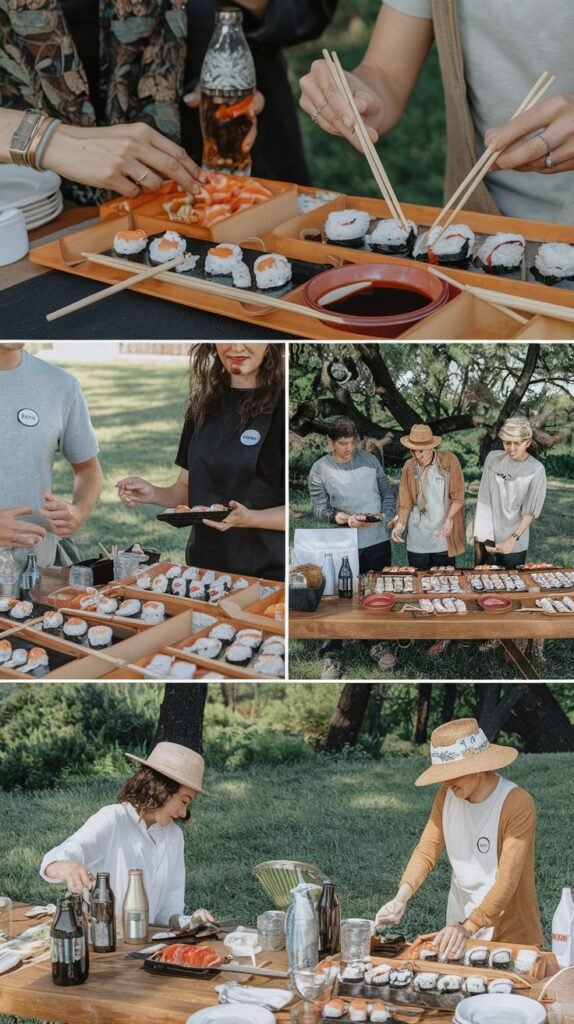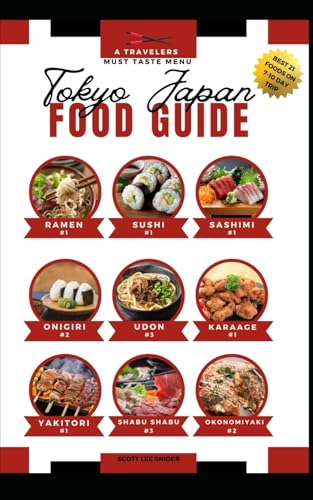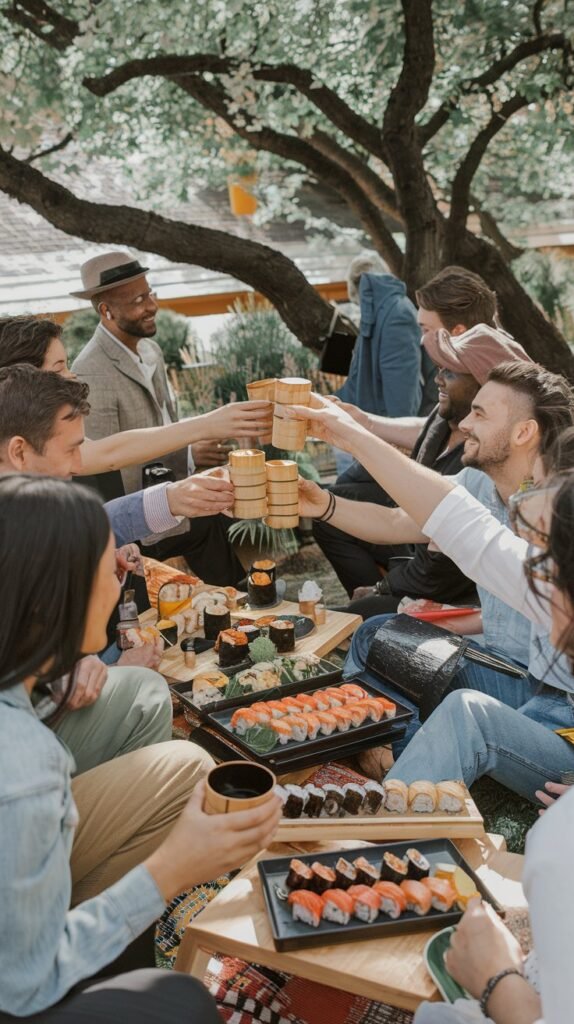Sushi picnics offer a delightfully unexpected twist on traditional outdoor dining, combining the elegant precision of Japanese cuisine with the casual freedom of alfresco gatherings. These refreshing celebrations bring together beautifully crafted sushi rolls, fresh ingredients, and Eastern-inspired accompaniments in a portable format that transforms ordinary parks, beaches, or backyard settings into extraordinary culinary adventures that surprise and delight guests.
Let’s explore how to create the perfect sushi picnic that balances authentic flavors with practical outdoor entertaining success!
Sushi Picnic Planning Fundamentals
Establish the perfect foundation for your Japanese-inspired outdoor celebration.
Understanding Modern Sushi Picnic Approaches
Creating authentic yet outdoor-friendly Japanese dining experiences:
- Food Safety Priority: Temperature management for raw ingredients
- Simplified Selection Focus: Travel-friendly sushi varieties
- Portable Presentation Emphasis: Elegant service in outdoor settings
- Traditional-Modern Balance: Authentic elements adapted for picnics
- Weather Consideration Integration: Protection for delicate items
- Surface Stability Requirements: Flat serving areas for precision foods
- Waste Management Planning: Leave-no-trace approach to outdoor dining
“Sushi picnics require a thoughtful balance between authentic Japanese dining traditions and practical outdoor considerations,” shares Mei, who specializes in Asian-inspired gatherings. “We approach these events with what we call ‘portable precision’—carefully adapting traditional sushi experiences for outdoor enjoyment without compromising quality. The most successful sushi picnics focus on simplified selections that travel well while maintaining visual impact and flavor integrity.”
Location Selection Strategy
Finding the perfect outdoor setting for Japanese cuisine:
- Flat Surface Availability: Stable foundation for precise presentation
- Shade Consideration: Protection for temperature-sensitive items
- Weather Backup Planning: Alternative options for sudden changes
- Seating Comfort Analysis: Appropriate arrangements for Eastern dining
- Water Access Evaluation: Hand-cleaning necessities for tactile eating
- Privacy Assessment: Appropriate atmosphere for focused enjoyment
- Travel Distance Calculation: Minimizing transportation time for freshness
“Selecting the right location creates the essential foundation for sushi picnic success,” explains Jordan, who plans diverse outdoor gatherings. “We’ve found the most effective approach is what we call ‘environment matching’—identifying spaces that naturally support Japanese dining traditions. We particularly recommend seeking locations with natural shade to maintain food safety, flat surfaces for stable presentation, and reasonable privacy that creates atmosphere without complete isolation. Parks with established picnic areas often provide ideal infrastructure, while private gardens or beach coves can create more intimate settings when properly prepared.”
Sushi Transportation Planning
Maintaining quality from kitchen to outdoor setting:
- Temperature Integrity Strategy: Proper cooling systems for raw items
- Vibration Reduction Consideration: Movement protection during transit
- Presentation Preservation Planning: Maintaining visual appeal in travel
- Appropriate Timing Calculation: Minimizing pre-service duration
- Component Separation Approach: Preventing moisture migration
- Condiment Transportation Strategy: Leak prevention for liquid items
- Equipment Organization Planning: Logical unpacking sequence
“Sushi transportation requires specialized techniques that preserve both safety and presentation quality,” shares Taka, who specializes in mobile Japanese cuisine. “We develop what we call ‘preservation pathways’—strategic systems that maintain food integrity from preparation to outdoor service. We generally recommend preparing rolls slightly thicker than traditional restaurant service for improved structural stability, packing components in specialized coolers with cold packs positioned to create even temperature zones, and transporting garnishes separately with final assembly at the destination for optimal freshness and presentation.”
Sushi Picnic Food
Outdoor-friendly Japanese cuisine designed for alfresco enjoyment.
Sushi picnic cuisine focuses on varieties that maintain quality outside traditional restaurant settings while delivering authentic Japanese flavors. The ideal approach prioritizes sturdy roll construction, simplified selection that travels well, and complementary items that enhance the experience without requiring elaborate on-site preparation or temperature-sensitive service.
| Travel-Friendly Sushi Rolls | Outdoor-Appropriate Sides | Complementary Japanese Items | Simplified Dessert Options |
|---|---|---|---|
| California Rolls | Edamame Pods | Cucumber Sunomono Salad | Mochi Rice Cakes |
| Spicy Tuna Rolls | Cold Soba Noodles | Portable Miso Soup | Fresh Fruit Skewers |
| Vegetable Futomaki | Seaweed Salad | Onigiri Rice Balls | Green Tea Cookies |
| Shrimp Tempura Rolls | Japanese Pickles | Cold Gyoza Dumplings | Dorayaki Pancakes |
| Avocado Rolls | Sesame Cucumber | Inari Sushi Pockets | Matcha Brownies |
| Philadelphia Rolls | Hijiki Seaweed Salad | Tamagoyaki Egg Slices | Sesame Seed Brittle |
| Cooked Unagi Rolls | Sliced Ginger Carrots | Cold Yakitori Skewers | Fruit Daifuku |
| Spicy Crab Rolls | Japanese Potato Salad | Vegetable Tempura | Green Tea Rice Balls |
Creating Sushi Picnic Food Successfully
Techniques for authentic yet practical outdoor Japanese dining:
- Travel-Sturdy Construction Priority: Rolls that maintain integrity
- Temperature-Safe Selection Focus: Items appropriate for variable conditions
- Pre-Cutting Preparation Strategy: Ready-to-eat convenience
- Simple Assembly Approach: Minimizing on-site preparation
- Condiment Packaging Technique: Spill-resistant individual portions
- Visual Impact Enhancement: Beautiful presentation despite transportation
- Dietary Consideration Integration: Identifiable options for varied needs
“I approach sushi picnic food with what I call ‘structured simplicity’—creating Japanese cuisine that solves outdoor dining challenges while delivering authentic flavors,” shares Yumi, who specializes in portable Asian cuisine. “We emphasize selecting varieties that maintain structural integrity during transport, using slightly stronger nori wrapping than traditional service, and focusing on fully cooked or vegetable options for enhanced food safety. We particularly recommend preparing complementary items like edamame, seaweed salad, and cold soba noodles that actually benefit from advance preparation and chilling, creating a full dining experience with minimal risk.”
Sushi Picnic Activities
Engaging entertainment that enhances your Japanese outdoor experience.
Japanese-inspired activities create memorable engagement opportunities beyond just dining, transforming your sushi picnic into an immersive cultural experience. The ideal approach incorporates elements that are portable, weather-resistant, and accessible to participants with varied experience levels while authentically connecting to Japanese traditions in respectful, meaningful ways.
| Interactive Games | Cultural Learning Activities | Creative Craft Opportunities | Physical Movement Options |
|---|---|---|---|
| Chopstick Challenges | Basic Japanese Phrase Learning | Portable Origami Station | Hanetsuki Badminton |
| Kendama Skill Practice | Sushi Identification Cards | Furoshiki Wrapping Lessons | Tai Chi in Nature |
| Japanese Card Games | Matcha Tea Ceremony Mini-Lessons | Washi Paper Crafting | Outdoor Daruma Otoshi |
| Lucky Fortune Game | Haiku Poetry Creation | Folding Fan Decoration | Japanese Garden Yoga |
| Sake Cup Ring Toss | Japanese Etiquette Sharing | Calligraphy Practice Cards | Cherry Blossom Dance |
| Koi Koi Card Game | Regional Cuisine Exploration | Koinobori Fish Kite Making | Zen Meditation Moment |
| Outdoor Shogi (Japanese Chess) | Japanese Art Appreciation Cards | Temari Thread Ball Creation | Nature Photography Walk |
| Portable Pachinko | Seasonal Festival Traditions | Ema Wish Plaque Decoration | Stone Stacking Challenge |
Creating Engaging Sushi Picnic Activities
Techniques for meaningful cultural engagement outdoors:
- Simplicity Priority: Easy-to-learn activities with quick engagement
- Cultural Respect Focus: Authentic elements presented appropriately
- Weather Adaptation Strategy: Activities suitable for variable conditions
- Multi-Age Consideration: Engagement across different experience levels
- Learning-Fun Balance: Educational value with entertainment priority
- Portable Design Requirement: Lightweight, compact activity components
- Japanese Connection Enhancement: Relevant tie-ins to sushi experience
“I approach sushi picnic activities with what I call ‘playful immersion’—creating entertaining engagement that naturally introduces elements of Japanese culture,” shares Hana, who specializes in Japanese cultural events. “We emphasize selecting activities that can be enjoyed in short sessions between dining, requiring minimal setup or specialized knowledge while creating memorable moments. We particularly recommend incorporating at least one physical activity like hanetsuki (Japanese badminton) that encourages movement after sitting, one tactile craft like origami that creates a take-home memory, and one social game like chopstick challenges that generates laughter and shared experience while subtly building appreciation for Japanese traditions.”
Sushi Picnic Beverages
Refreshing sips that complement your outdoor Japanese experience.
Sushi picnic beverages should balance traditional Japanese drinking culture with practical outdoor service considerations. The ideal approach creates refreshing, complementary options that enhance the sushi experience while addressing the unique challenges of open-air dining situations from temperature maintenance to portable serving methods.
| Japanese Iced Teas | Sake & Beer Options | Refreshing Non-Alcoholic Choices | Special Outdoor Beverage Elements |
|---|---|---|---|
| Green Tea Over Ice | Individual Sake Bottles | Cucumber-Mint Water | Portable Matcha Service |
| Cold-Brewed Hojicha | Canned Japanese Beer | Yuzu Citrus Spritzer | Sakura Cherry Blossom Tea |
| Mugicha Barley Tea | Sparkling Sake | Lychee-Infused Water | Specialized Ice Program |
| Jasmine Tea Infusion | Chilled Nigori Sake | Japanese Ramune Soda | Individual Serving Bottles |
| Genmaicha Over Ice | Fruit-Infused Sake | Melon Cream Soda | Bamboo Cup Service |
| Iced Oolong Tea | Dry Japanese Cider | Aloe Vera Drink | Specialized Tea Flask |
| Cold Sencha | Junmai Ginjo Selection | Shiso Herb Lemonade | Portable Hot/Cold Systems |
| Fruited Green Tea | Seasonal Beer Selection | Ume Plum Drink | Travel-Friendly Sake Sets |
Creating Sushi Picnic Beverages Successfully
Techniques for refreshing yet practical outdoor drink service:
- Temperature Maintenance Priority: Proper cooling systems for refreshment
- Simplified Serving Strategy: Easy outdoor-friendly pouring methods
- Traditional Adaptation Approach: Japanese beverages modified for picnics
- Non-Alcoholic Option Enhancement: Sophisticated alcohol-free choices
- Pre-Batched Preparation Focus: Advance mixing for service efficiency
- Portable Vessel Selection: Practical yet authentic drinking containers
- Complementary Flavor Development: Drinks that enhance sushi enjoyment
“I approach sushi picnic beverages with what I call ‘refreshing authenticity’—offering traditional Japanese drink experiences adapted for outdoor enjoyment,” shares Hiro, who develops specialized Japanese beverage programs. “We recommend focusing on pre-chilled options that maintain temperature with minimal ice dilution, utilizing insulated containers that preserve quality while preventing condensation issues outdoors. The ideal approach includes traditional Japanese iced teas prepared slightly stronger than usual to account for ice melt, individual-sized sake bottles or cups that eliminate the need for complex pouring services, and at least two sophisticated non-alcoholic options featuring traditional Japanese flavors like yuzu, shiso, or cucumber.”
Creating the Perfect Sushi Picnic Atmosphere
Transform your outdoor space into an authentic Japanese dining environment.
Comfortable Japanese-Inspired Seating
Creating authentic dining postures outdoors:
- Traditional Posture Adaptation: Floor-style seating for outdoor surfaces
- Comfortable Support Priority: Enhanced cushioning for extended dining
- Height Consideration Strategy: Appropriate table-to-seat relationships
- Portable Design Requirement: Lightweight yet stable constructions
- Weather Resistance Enhancement: Moisture and soil barrier integration
- Physical Comfort Balance: Accessibility across varied physical abilities
- Authentic Arrangement Focus: Traditional Japanese seating patterns
“I approach sushi picnic seating with what I call ‘grounded comfort’—creating traditional Japanese dining postures that remain practical in outdoor settings,” explains Aki, who designs portable Asian dining experiences. “We begin with specialized picnic blankets featuring enhanced waterproof backing and cushioned support, layering with portable zabuton-style floor cushions that provide both authentic posture and essential comfort on uneven ground. We typically recommend low folding tables approximately 12-15 inches in height that maintain traditional proportions while providing stability on outdoor surfaces, positioned to create intimate dining arrangements while allowing natural movement and conversation.”
Portable Japanese Decoration Strategy
Creating authentic atmosphere in outdoor settings:
- Minimalist Transportation Focus: Lightweight yet impactful elements
- Natural Element Integration: Botanical components that reflect Japanese aesthetics
- Weather Resilience Priority: Decorations that withstand outdoor conditions
- Simple Assembly Requirement: Quick setup without elaborate installation
- Visual Impact Enhancement: Strategic placement for maximum effect
- Cultural Authenticity Balance: Respectful adaptation of Japanese elements
- Practical Functionality Consideration: Decorative items with useful purposes
“Sushi picnic decoration creates both atmosphere and cultural context, requiring thoughtful balance between aesthetic impact and practical portability,” shares Mika, who designs Japanese-inspired environments. “We develop what we call ‘essential atmosphere’—focusing on a few perfectly selected elements rather than elaborate displays. We emphasize portable items with disproportionate visual impact, such as furoshiki wrapping cloths that transition from transportation tools to table coverings, miniature potted plants that create natural focus points, and traditional tenugui towels that serve both decorative and practical functions while establishing authentic Japanese visual language without cultural caricature.”
Sushi Picnic Hosting Execution
Being a gracious host while managing an outdoor Japanese experience.
Cultural Guidance Facilitation
Ensuring comfortable Japanese dining experiences:
- Eating Technique Demonstration: Gentle chopstick and soy usage guidance
- Flavor Progression Explanation: Traditional tasting sequence suggestions
- Cultural Context Sharing: Appropriate background without overwhelming
- Participation Comfort Priority: Reducing intimidation for new experiences
- Individual Adaptation Respect: Acknowledging personal preferences
- Authentic-Accessible Balance: Traditional elements with practical adaptation
- Curiosity Encouragement Focus: Creating learning opportunities naturally
“Effective cultural facilitation transforms sushi picnics from mere outdoor meals into meaningful Japanese experiences,” shares Keiko, who specializes in Japanese cultural events. “We focus on what we call ‘accessible authenticity’—creating genuine cultural connections without intimidation. This begins with thoughtful guidance as guests arrive—perhaps demonstrating proper soy sauce pouring techniques or explaining the traditional order of enjoying different items—while maintaining warm reassurance that personal enjoyment matters more than perfect adherence to tradition. The most successful hosts create natural learning moments throughout the experience rather than formal instruction.”
Outdoor Service Flow Management
Coordinating Japanese dining despite nature’s challenges:
- Weather Monitoring Priority: Ongoing condition assessment
- Temperature Management Strategy: Maintaining food safety standards
- Course Progression Planning: Appropriate pacing despite outdoor setting
- Supply Accessibility Organization: Logical arrangement for service needs
- Guest Comfort Maintenance: Physical considerations in natural settings
- Waste Reduction Approach: Minimizing environmental impact
- Natural Interruption Contingency: Flexibility for unexpected elements
“Service flow management for outdoor Japanese dining ensures guests enjoy an authentic experience while addressing nature’s unique challenges,” explains Mitsuki, who coordinates outdoor Asian events. “We develop what we call ‘flexible tradition’—maintaining essential cultural elements while adapting to outdoor realities. We recommend creating a specific serving sequence that prioritizes temperature-sensitive items early in the experience, utilizing multi-lidded containers that allow progressive revealing of different courses while protecting them from elements, and maintaining a designated ‘service area’ slightly separate from the main dining space where supplies remain organized and protected throughout the gathering.”
Special Sushi Picnic Variations
Adapt your approach for different occasions and settings.
Beach Sushi Picnics
Creating Japanese experiences despite coastal challenges:
- Sand Management Strategy: Surface stabilization techniques
- Sun Protection Priority: Shade systems for temperature-sensitive foods
- Wind Resistance Planning: Securing lightweight items effectively
- Specialized Equipment Focus: Beach-appropriate serving pieces
- Salt Air Consideration: Protection for delicate flavors
- Water Access Integration: Simplified hand-cleaning solutions
- Elevated Service Surface Requirement: Sand-free dining platforms
“Beach sushi picnics create stunning settings for Japanese cuisine when thoughtfully designed to address coastal challenges,” explains Mari, who plans oceanside Asian gatherings. “We approach these events with what we call ‘stabilized elegance’—creating protected micro-environments within the beach setting. We particularly recommend specialized beach tables with wide, stable legs that provide flat serving surfaces above the sand, strategic wind barriers positioned to protect food without blocking views, and simplified roll selections focusing on nori-wrapped varieties rather than looser preparations that can be affected by coastal breezes. For particularly successful beach sushi experiences, consider timing that takes advantage of lower temperatures and reduced crowds, perhaps early evening hours when the setting sun creates spectacular atmosphere without excessive heat.”
Romantic Sushi Picnics for Two
Creating intimate Japanese dining experiences:
- Private Location Selection: Secluded setting identification
- Enhanced Atmosphere Focus: Elevated ambiance development
- Specialized Service Strategy: Feeding-each-other opportunities
- Intimate Seating Arrangement: Close proximity configuration
- Premium Selection Priority: Special occasion quality elevation
- Interactive Element Integration: Shared preparation activities
- Memory Creation Enhancement: Keepsake components and photography
“Intimate sushi picnics for couples require heightened attention to atmospheric details and interaction opportunities,” shares Yuki, who designs romantic Japanese experiences. “We develop what we call ‘shared discovery’—creating moments of connection through Japanese culinary traditions. We recommend selecting secluded locations with natural beauty but sufficient privacy, arranging seating side-by-side rather than across from each other to create shared perspective, and incorporating at least one interactive element like simple hand roll preparation that creates memorable participation. The most successful romantic sushi picnics balance practical outdoor dining with special touches like individual sake serving rituals, premium ingredient selections, or traditional Japanese dessert moments that elevate the experience beyond everyday dining.”
More Creative Sushi Picnic Inspiration
Looking for additional Japanese outdoor dining ideas? Here’s a collection of creative concepts!
| Sushi Picnic Themes | Interactive Elements | Creative Food Presentations | Sophisticated Enhancement Ideas |
|---|---|---|---|
| Cherry Blossom Celebration | Hand Roll Station | Sushi Mosaic Design | Japanese Paper Lanterns |
| Zen Garden Experience | Wasabi Mixing Ritual | Temaki Hand Roll Cones | Sake Flight Tasting |
| Tokyo Street Food | Portable Sushi Mat Rolling | Sushi in Bamboo Boats | Calligraphy Place Settings |
| Traditional Tea Ceremony | Chopstick Skills Games | Tiered Bento Box Display | Bamboo Wind Chimes |
| Regional Japan Exploration | Edamame Shooting Contest | Color-Coordinated Maki | Live Shamisen Music |
| Seasonal Japan Celebration | DIY Pickled Ginger | Sushi Served on Ice Blocks | Japanese Poetry Sharing |
| Coastal Japanese Fishing Village | Seaweed Wrapping Station | Nigiri on Individual Stones | Ikebana Flower Arrangements |
| Modern Tokyo Interpretation | Sushi-Sandwich Hybrid Creation | Sushi “Bouquet” Presentation | Japanese Textile Accents |
Conclusion: Celebrating Connection Through Japanese Culinary Traditions
Sushi picnics create memorable outdoor gatherings through the perfect combination of authentic Japanese flavors, thoughtful outdoor adaptations, and creatively designed social environments that transform ordinary natural settings into extraordinary cultural experiences.
What makes sushi picnics extraordinary is their ability to create unexpected cultural experiences in everyday outdoor settings, where traditional Japanese culinary precision meets the casual freedom of open-air dining. When thoughtfully planned with attention to both authentic flavors and practical outdoor considerations, these alfresco Japanese gatherings offer uniquely effective opportunities for introducing friends and family to Eastern dining traditions within comfortable, approachable contexts that create lasting memories.
So prepare your travel-friendly sushi selections, pack your portable Japanese serveware, and choose your perfect outdoor location for an afternoon of authentic Eastern flavors under open skies. The connections formed during these outdoor celebrations often become the foundation for deeper appreciation of Japanese culinary traditions that extends far beyond a single day of sushi and sunshine.

